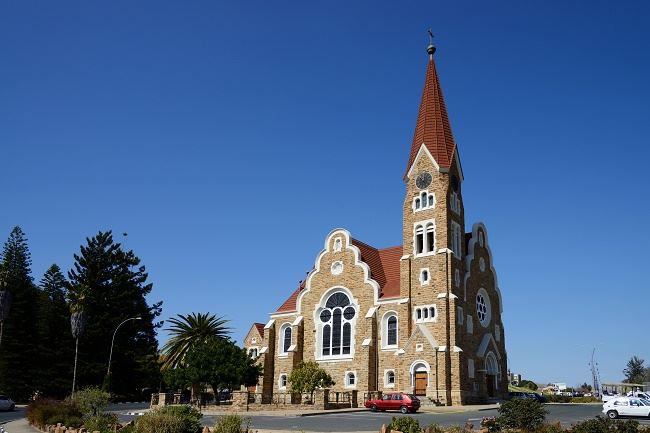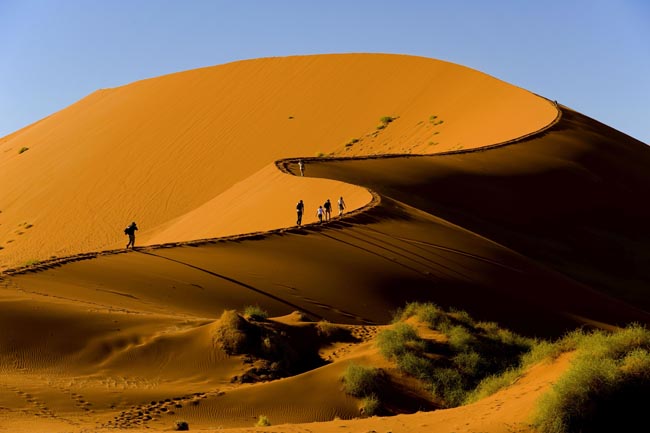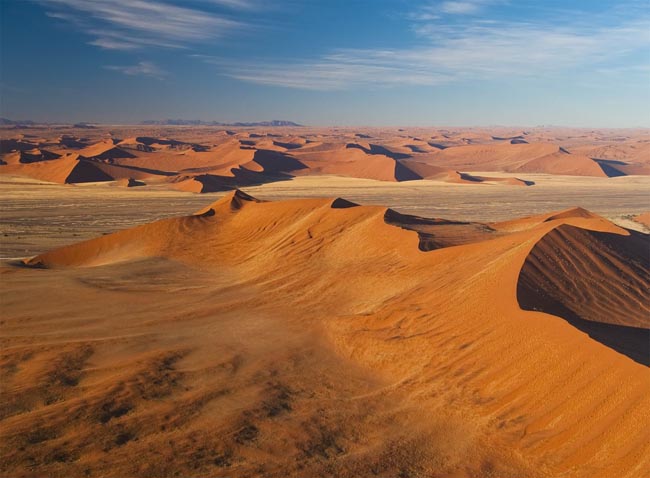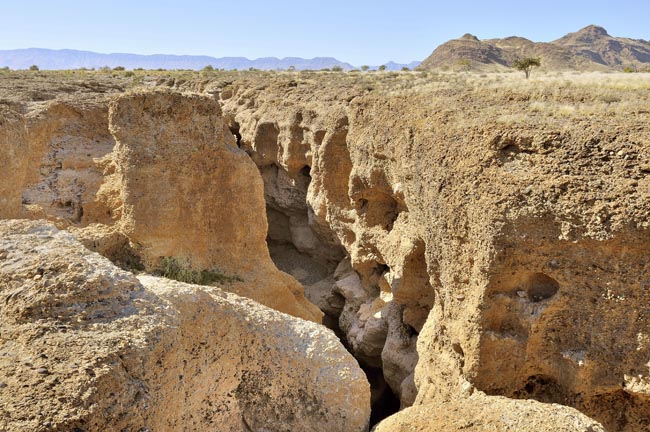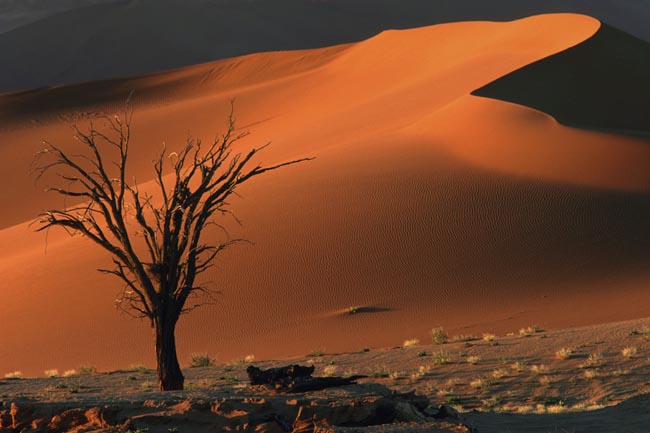This 12-day Namibia tour takes us along the dense streets of its capital city, Windhoek, where we walk among people from the numerous tribes that wear a mixture of traditional and contemporary dress.
This country's captivating history shines through its architecture from the turn of the century, but a sense of modernism is kept alive through its vibrant culture.
Once we're outside of the city, the colourful Sossusvlei sand dunes tower above us with their record-breaking heights of 300 metres.
What would a trip to Africa be without a day spent game-viewing? Etosha National Park's "salt desert" is an important resource for the mixture of wildlife that inhabits this land.
Namib-Naukluft National Park yields an excellent display of animals as diverse as the baboon, rock hyrax or leopard. Our time on Botswana features the incredible wildlife diversity of both Chobe Park and the Okavango Delta.
This is a perfect adventure through a regiony that serves as an excellent showcase of what makes Africa such a compelling continent for so many travellers.
Prices below are per person, twin-sharing costs in US Dollars (USD). Pricing does not include airfare to/from the tour and any applicable taxes. For single supplement rates and taxes (if any), please refer to below Prices & Dates table. For general information on flights to/from the tour, click here.
Your Travel and Accommodation Arranged For You
Tips Included for Driver, Restaurant Staff, Local Guides
Authentic Local Experiences With Lots Of Inclusions.
Select a date below to reserve your spot:
Optional Single Supplement: $850 USD (number of singles limited).
This tour may require a mandatory single supplement charge of $430 if you join our share program and we are unable to pair you.
Download Itinerary
Day 1 Arrival in Namibia
Arrival in Windhoek, the capital of Namibia.
As capital cities go, Windhoek is very relaxed with a whole mixture of Namibia's tribes strolling the streets. Many are in traditional dress and others are in stylish contemporary clothes often with magnificent plaited hairstyles. The city is full of trees and gardens, plus some splendid buildings dating from the turn of the century, all jumbled up with post-modernist office blocks in a swirl of ethnic mix.
Today you will meet our Namibia-based Tour Leader and enjoy a welcome dinner this evening.
Please note: Due to space availability and other considerations, our Namibia itinerary may run in reverse order (Windhoek to Windhoek).
Overnight in Windhoek.
Included Meal(s): Dinner
Day 2 Windhoek - Namib-Naukluft National Park
Today we leave the interior plateau region and head southwest through the Gamsberg Pass to the Namib Desert, through magnificent colours, pastel-basted rock formations, and waves of taupe-coloured grasses. Even the clouds are tinged orange-pink as distant dunes reflect their colour skywards. In the Nama language, Namib means vast, and this is an understatement. At the opposite end of the moisture scale is the parched Namib Desert with endless orange dunes blown into razor sharp ridges by the sand-shifting wind. The famous Sossusvlei sand dunes at 300m (1,000 ft), are the highest in the world, towering over their nearest rivals in Arabia, and just begging to be climbed barefoot.
Animals, insects, and plants have adapted to live in this generally inhospitable region and apart from infrequent rains, rely on the sea mist that rolls far inland. En route we have the chance to see kudu, springbok, gemsbok and black eagles set againstsome of the most expansive and dramatically rugged scenery in the world.
En route we have several stops for scenery viewing and photos. Upon arrival this afternoon you will have time to wander the land around our lodge and enjoy the multi-hued sands, strange twisted acacia trees, and almost guaranteed perfect sunset.
We will have a picnic lunch en route.
Overnight in the vicinity of the Namib-Naklauft National Park.
Included Meal(s): Breakfast, Lunch and Dinner
Not finding what you're looking for?
Our specialists can take away the stress and create a private custom tour tailored to your exact interests and budget.
Day 3 Namib-Naukluft National Park
Very early this morning we drive into the park to a special place called Sossusvlei, a huge dried up pan (vlei) which sporadically holds water, at the base of some of the most spectacular dunes in the Namib. We watch the morning sun light up the apricot coloured sands, the long shadows accentuating the graceful, almost feminine curves of the dune crests.
These immense rich ochre sand dunes are one of the most wondrous sights in the world. Geologists say that this desert, covering most of the Namib-Naklauft Park, could be the oldest in the world. The older the dune, the brighter the colour from slow iron oxidisation and minute fragments of garnets. Dwarfed by the sheer size of the dunes, your footprints look like insect trails and each step forward forms a mini sand-slide. The solitude is immeasurable and your place in the great scheme of life takes on a curious insignificance. Visually powerful and deafeningly silent, this unforgettable experience is a high point of our visit to the Namib. Possible game sightings include oryx antelope, springbok, or ostrich.
At Sossusvlei we have plenty of time to walk into the heart of the dunes, scale a dune or two for panoramic views, and walk across the sand to a pan called Dead Vlei. This spooky place is named as such because of the blackened dead acacia trees that "sprout" from a blinding white pan against an orange dune backdrop. Stupendous.
On our way back to our accommodation we will make a stop at Sesriem Canyon, located near the entry gate to Sossussvlei. It was an important source of water for early inhabitants and even during dry times there is water in the upper reaches, where deep clefts in the rock reduce evaporation. Explorers, transport riders and early travellers used to lower a bucket
down to collect the water and it normally took 6 lengths of thong tied together, hence the Afrikaans name 'Ses' meaning six, and 'Riem' meaning thong. The canyon was formed by the Tsauchab River rising in the Naukluft and Zaris Mountains to the east, and flowing through to Sossusvlei. Walking through the canyon takes you on a journey back 10-20 million years ago
when sedimentary layers of gravel and sand were deposited and cemented together by lime. The ledges are now inhabited by pigeons, raucous pied crows and chattering starlings.
We'll have a picnic breakfast en route and likely a late lunch upon return to our lodge.
Overnight in the vicinity of the Namib-Naklauft National Park.
Included Meal(s): Breakfast, Lunch and Dinner
Day 4 Namib-Naukluft Park - Swakopmund
We continue our journey north through Namib-Naukluft Park via Solitaire and the spectacular rocky Kuiseb Canyon (photo stops en route) -- with possible sightings of baboon, rock hyrax, or, if lucky, leopard -- to the German colonial resort town of Swakopmund. This is Namibia's second biggest town and traditional "summer capital", and one of themost surreal places in this surreal country. You approach the town through the endless expanses of the Namib Desert, one of the world's largest wilderness areas. Then, through the mists (it is almost always misty in the morning and late afternoon) Bavarian spires and elaborate Germanic architecture rise through the fog banks. The boom of the surf on the notorious Skeleton Coast is an ever-present reminder of the icy Atlantic Ocean beyond.
We will have some time for a stroll around town before dinner.
Overnight in Swakopmund.
Included Meal(s): Breakfast, Lunch and Dinner
Day 5 Swakopmund: Leisure Time & Optional Activities
Today is free to wander the streets of charming Swakopmund. The town is an eclectic mixture of Bohemian and Bavarian, home to an intriguing mix of artists, hippies, strait-laced descendants of German settlers, stately Herero women in Victorian dress, and hardened miners, game rangers, safari operators and fishermen. Swakopmund exudes romance and history, a rich cultural melting pot of old and new. Nighttime entertainment ranges from sophisticated spins on the casino's roulette wheels, through raucous parties at the many pubs and restaurants, to an assortment of drama, music and cultural events. It is indeed odd to be in a little corner of old Bavaria wedged between one of the world's harshest deserts and even harsher coastlines.
You may wish to participate in an optional activity, including "Living Desert" excursions of the amazingly diverse Namib Desert biosphere; marine cruises on the Walvis Bay lagoon and outer harbour, scenic flights, camel rides, and many more (your Tour Leader can advise on current pricing and book in advance once you arrive on the tour).
Overnight in Swakopmund.
Included Meal(s): Breakfast and Dinner
Day 6 Swakopmund - Damaraland
After an early breakfast the road takes us north and east into the wonderful and diverse region of Damaraland. We pass Namibia’s highest mountain, the Brandberg, which peaks at 2573 m above sea level, and take time to view game and absorb the vastness of the scenery along the way. Weu make our way into the heart of Damaraland where we will spend the next two nights at our specially erected Under Canvas Camp ("Huab Under Canvas").
Damaraland is typified by displays of colour, magnificent table-top mountains, rock formations and bizarre-looking vegetation. The present day landscape has been formed by the erosion of wind, water and geological forces which have created rolling hills, dunes, gravel plains and ancient river terraces. It is the variety and loneliness of the area as well as the scenic splendour which will reward and astound you, giving one an authentic understanding of the word 'wilderness'.
If time allows this afternoon (or tomorrow if we are running late) we will visit the nearby attractions and geological sites of the pre-historic Twyfelfontein rock engravings (recently declared a UNESCO World Heritage Site). We will arrive in the late afternoon after a long yet rewarding day -– with time to enjoy sundowners before dinner.
Overnight in Damaraland.
Included Meal(s): Breakfast, Lunch and Dinner
Day 7 Damaraland Touring
Today is dedicated to exploring this remarkable and fascinating area with our guides. After an early breakfast we will be treated to a memorable 4x4 excursion along the ephemeral Aba Huab River valleys to explore this remarkable region and to search for game, including the elusive desert adapted elephants if they are in the area. Damaraland is home to a variety of desert adapted wildlife and hidden desert treasures. As the elephants are mostly active in the mornings we will normally have the best chance to see them then before returning to camp for lunch. However, if all avellers are in agreement, we could possibly take a picnic lunch and stop to enjoy that in the shade of a large Ana tree by the riverbed, ideally while watching a herd of elephant browsing nearby. On return to camp there should be time to relax and enjoy some pre-dinner drinks while admiring the stunning views of your surroundings at sunset.
Overnight in Damaraland.
Included Meal(s): Breakfast, Lunch and Dinner
Day 8 Damaraland - Etosha National Park
This morning after breakfast we will continue our safari to Etosha National Park. Lunch is had en route and if time allows this afternoon our guide will take us on a game drive into Etosha, exiting the park before the gates close at sunset. The rest of the evening can be spent game viewing at the camp's floodlit waterhole.
Overnight at Etosha (West).
Included Meal(s): Breakfast, Lunch and Dinner
Day 9 Etosha National Park
Today is dedicated to a full day of exciting game viewing within the central and eastern sections of Etosha National Park from the comfort of our private safari vehicle/s. We drive our way from the southern Andersson’s Gate to Halali (where we may stop for lunch) and then on across via selected waterholes such as Goas, which are normally particularly good for
game viewing, to Namutoni Camp in the east, eventually leaving the park before sunset, arriving with enough time to relax and freshen up before for dinner.
Etosha National Park covers 22,270 km², of which approximately 5,000 km² is made up of saline depressions or 'pans'. The largest of these pans, the Etosha Pan, can be classified as a saline desert in its own right. The Etosha Pan lies in the Owambo Basin, on the north-western edge of the Namibian Kalahari Desert. Until three million years ago it formed part of a huge, shallow lake that was reduced to a complex of salt pans when the major river that fed it, the
Kunene, changed course and began to flow to the Atlantic instead. If the lake existed today, it would be the third largest in the world. Etosha is the largest of the pans at 4,760 km² in extent. It is nowadays filled with water only when sufficient rain falls to the north in Angola, inducing floods to flow southward along the Cuvelai drainage system.
The park consists of grassland, woodland and savannah. Game-viewing centers on the numerous springs and waterholes where several different species can often be seen at one time. The park boasts some 114 mammal and over 340 bird species. Wildlife that one might see includes elephant, lion, giraffe, blue wildebeest, eland and kudu.
Overnight Etosha (East).
Included Meal(s): Breakfast, Lunch and Dinner
Day 10 Etosha National Park
Full day of exciting game viewing within the eastern section of Etosha National Park. Our day and lunch placement are somewhat free-form to take into account seasonal variations, weather, and travellers' interest.
Overnight at Etosha-East.
Included Meal(s): Breakfast, Lunch and Dinner
Day 11 Etosha - Windhoek
After a leisurely breakfast we set off on our journey back to Windhoek. The road takes us south through Namibia's central highlands and commercial farmlands to reach Windhoek for the last night of our safari. We can visit Lake Otjikoto along the way and spend some time in Okahandja at the local woodcarver’s craft market where you can do some last minute curio shopping if desired.
Overnight in Windhoek.
Included Meal(s): Breakfast, Lunch and Dinner
Day 12 Departure
Today we depart from Windhoek.
BON VOYAGE!
Included Meal(s): Breakfast
Inclusions
Breakfast and dinner daily (hotels and restaurants); most lunches.
All accommodation, transport, sightseeing and entrance fees for sites noted as 'visited' in the detailed itinerary.
Gratuities for drivers, local guides, restaurant staff, porters.
Our Namibia/Botswana tours are an EXCEPTION to our usual policies around airport transfers, which we INCLUDE for all passengers regardless of whether you book your air through us or not.
Exclusions
International airfare to/from the tour.
Tour Leader gratuities, some lunches, drinks, personal items (phone, laundry, etc), international (if applicable) air and airport taxes.
Optional trip cancellation insurance.
Our post-reservation trip notes offer further guidance on shopping and not included meals.
Our Namibia/Botswana tours are an EXCEPTION to our usual policies around airport transfers, which we INCLUDE for all passengers regardless of whether you book your air through us or not.
Seasonality and Weather
November to April:
The ‘rainy’ season is during the summer months, from November to April. The weather tends to be hot and humid with dramatic afternoon thunderstorms. However, the downpours are short and heavy, so it's unlikely that the rain will disrupt your travel plans -- meaning that you don't have to worry about when to go to Namibia because even the rainy season is a great time to visit. March can also be a good time to visit Namibia's Etosha National Park; following the birthing season in January and February, you will be able to see young animals taking their first steps in the wild. That said, the lush vegetation seen in March to May can make game viewing more challenging.
June to October:
The ‘dry’ season takes place during the winter months from May to October and the weather is typically warm and sunny, albeit with very cold nights. These months are considered to be the best time to go to Namibia, as you can enjoy uninterrupted blue skies and plenty of sunshine, except along the coast where there is often a fog. The daytime temperatures during these months are moderate, however it can get very cold in the evenings.
In terms of wildlife, the dry winter months (June-August) are ideal for game viewing in Etosha National Park because the vegetation is sparse and water sources dry out. Therefore, the local wildlife gathers around the permanent water holes, making animals easier to locate, observe and photograph.
Transport and Travel Conditions
Land transport in Namibia is via specialized 4x4 safari vehicles, equipped with air-conditioning and fridges for drinks and snacks.
All vehicles are equipped with:
• Roof pop-tops for better photography and game viewing vantage points
• Air-conditioning
• Onboard fridge/freezers and plenty of water.
• Personal library, which includes a series of guidebooks, maps, stationery and checklists.
• 220-volt electrical charging point, to charge electrical devices whilst travelling.
• Guaranteed window seat on every safari.
• VHF inter-vehicle radios that allow multi vehicle groups to communicate with each other while ‘on the road’
Namibia is a huge, sparsely-populated country with great distances between facilities. We stop for breaks as often as possible, but you must be prepared for some long days and some early starts.
Our transport in Botswana will be of a similar nature for our game drives in Chobe and road journeys.
Am I suitable for this tour? Please refer to our self-assessment form.
Activity Level: 1
No particular physical activity is involved other than town/city walks and short walks to dinners and sites of interest, some of which are large.
To learn more about the Activity levels, please visit our tour styles page.
Accommodation
Well-located, air-conditioned, 3&4-star hotels and lodges with en suite toilet and bath throughout. There is no camping on this trip.
Please click on the "Map & Hotels" tab for more information on accommodation typically used on this trip.
Staff and Support
Local Tour Leader throughout, drivers, local guides at various locations.
Group Size
Maximum 18 plus Tour Leader
Tour Extensions
This tour is part of a series that can be upgraded to make for a longer trip. For more options, please refer to tour code/s:
Tour Overview Countries Visited: 3 Acivity Level: 1 Tour Style: Cultural
On our Namibia and Botswana tour we'll be venturing into the back of beyond and through the stark beauty of untouched, barren wilderness in two unforgettable African destinations, where we spend a large portion of our tour marvelling at a natural environment yet thankfully untamed by humankind..
Technicolour landscapes of pastel-basted rock formations, waves of taupe grasses and orange-pink clouds mark our route as we journey to one of the largest conservation areas on the planet in Namibia, where we have the chance to see kudus, springboks and black eagles set against some of the most expansive and dramatically rugged scenery in the world.
Alone for miles and dwarfed by apricot-coloured sand dunes, we experience one of the high points of our tour, which can bring with it a profound, almost spiritual, effect on the senses.
Through German colonial towns with eclectic mixes of Bavarian and Bohemian architecture, we travel through unexpected and surreal scenery, and make our way to the Skeleton Coast, where we can take to the skies for an aerial view of seas of golden dunes, shipwrecks and perhaps the famous Damara desert-dwelling elephants.
We see geological oddities, examine some of Africa's finest prehistoric rock art, paintings and engravings that date from over 5,000 years ago, and gaze at teeming wildlife at perhaps the best-kept secret of African safari destinations.
As we cross into Botswana, the marshlands of the Okavango Delta serve as the ideal location to view hippos and crocodiles in their natural habitat and thereafter it's on to what is arguably the most spectacularly beautiful game park in Southern Africa; Chobe National Park.
The final days of our adventure deep in the heart of Africa are well-spent watching out for zebra, buffalo, wildebeest, antelope and, of course, elephants, cheetahs and lions, while we explore traditional and colonial villages, learn about the lives of indigenous peoples and take in the splendour of one of the natural world's most incredible sights in Zimbabwe; Victoria Falls.
Tour Overview Countries Visited: 3 Acivity Level: 1 Tour Style: Cultural
Our South Africa & Namibia Tour begins in the capital of South Africa - Johannesburg - and traces of its history stand out at every turn of the corner.
The area is still brimming with reminders of the colonial era; a period that saw immense growth upon the discovery of gold in the area.
Seeing examples of European influence as we pass through the many Gold Rush towns, such as the traditional Cape Dutch architecture of Stellenbosch or the many wineries of the surrounding area, is not restricted to South Africa.
As soon as we arrive in Windhoek, Namibia, we instantly realize it has a distinctly German feel to it.
Namibia offers more than an intricate history; it offers an immense track of land shining in full beauty.
Covering a record 5,000 square kilometres, Naukluft National Park is the largest conservation area in the world and we will feel the simple pleasure of having sand beneath our bare feet as we climb the famous Sossusvlei sand dunes, which also hold world records for their size.
Tour Overview Countries Visited: 4 Acivity Level: 1 Tour Style: Cultural
This exciting Southern Africa & Namibia Tour travels through five Southern African countries kicks off in Johannesburg, a remarkable city of contrasts known as 'The City of Gold.'
Since its foundation in the latter half of the 18th century and its subsequent boom was instigated by the discovery of an abundance of the material in the region; it remains to this day the gold capital of the world.
We meander down affluent streets lined with whitewashed mansions and grandiose residences, and saunter alongside poverty-stricken shanty towns of tin shacks and debris, all the while marvelling at the fact that the two are in incredibly close proximity to one another.
Jetting over to witness one of the world's most magnificent natural phenomena at Victoria Falls in Zimbabwe.
We take a few days to explore this abundant area rife with beautifully lush gorges, before making a short stop-off in Botswana to check out Chobe National Park with a river cruise and a spot of wildlife-viewing.
Our cultural exploration involves visiting British, German and Dutch colonial towns, traditional, mud-hut housed villages, bustling urban metropolises and quieter rural farming settlements; the entire gamut of cultural nuance on display in Southern Africa.
As well as treading off the beaten path, through delightful sceneries of dense rainforest, towering mountains, plunging valleys and colourful flora, we hit the major tourist hot-spots for which the area enjoys worldwide acclaim.
Our list of heavyweight attractions includes: the unforgettable rock-spiral vistas in Blyde River Canyon; Kruger National Park - South Africa's largest game reserve wherein is to be found lions, leopards, cheetahs, elephants and zebras; the dream-like technicolour landscapes of the area around the Namib desert in Namibia.
The best-kept secret of safari destinations in Namibia's Etosha National Park, whose astounding abundance of wildlife makes it perhaps the easiest place to view nature at its finest.
Tour Overview Countries Visited: 5 Acivity Level: 1 Tour Style: Cultural
Southern African Circuit Tour from Adventures Abroad: The bustling streets of cosmopolitan Johannesburg serve as the perfect introduction to our tour through the lands and cultures of the African south, since its extraordinary wealth of diversity epitomizes the cultural richness of the continent in its entirety.
From frenetic urban centres to wilderness, we travel through sweeping grasslands to Low Veld, an arid region characterized by rocky hills and acacia scrub forest, and on amid vast mountainscapes to admire the magnificent Blyde River Canyon.
Further south, we soak in the aptly named vistas of Wonder View, God's Window and the Pinnacle. No tour to these world-famous African safari destinations would be complete without making some attempt to investigate the teeming wildlife on display and our adventure cuts no corners in bringing you the best of nature.
Namibia's Etosha National Park, despite the fact that it is one of the world's largest national parks, is often referred to as the best-kept secret of African safari destinations; and Botswana's Okavango and Chobe parks offer views of huge herds of impala, wildebeest, zebras and elephants, prides of lions, packs of wild dogs and cheetahs.
As we make our leisurely course through four hugely rewarding and distinguished countries, we marvel at some of the most unforgettable sceneries on the planet; from the jaw-dropping panoramas atop Table Mountain in South Africa and the endless rolling hills of sugarcane in Swaziland, to the magnificent technicolour desolation of Namibia's Namib desert and our aerial view of the legendary marshlands of the Okavango Delta in Botswana.
Regions visited: Southern Africa
Countries visited: Namibia
*The red tour trail on the map does not represent the actual travel path.
The following is a list of sample hotels at some locations included on this tour. The hotels shown here are meant to provide a general sense of the standard of hotel we usually aim for; they are not necessarily confirmed for your chosen departure.




Experience the true art of Hospitality with the thoughtful touch of attentive staff to contribute to a truly memorable experience. Facilities include a sparkling pool, bar, sundowner deck, beer garden and an al fresco terrace where one can enjoy exquisite food, award-winning wines and magnificent views of the floodlit waterhole.




This is our Etosha accommodation for our stay at the eastern side of the park.




This lodge is our accommodation for the eastern part of the park.
